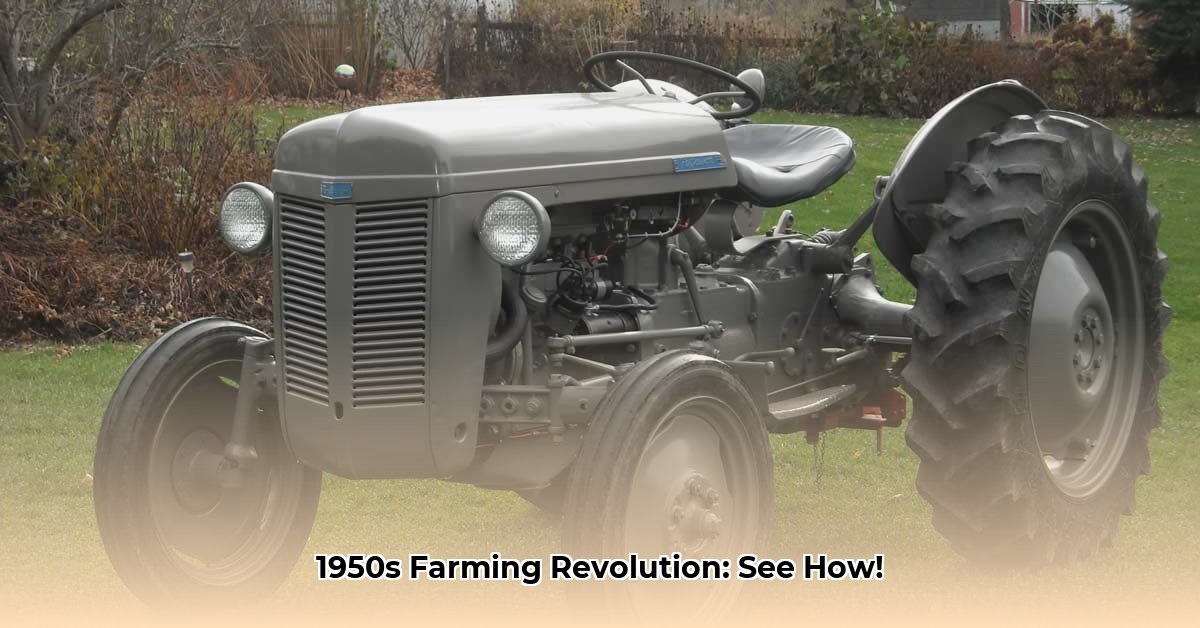
A Revolution in the Fields: From Backbreaking Labor to Mechanical Might
Imagine a world where farming was synonymous with backbreaking labor. Before the 1950s, planting, plowing, and harvesting relied almost entirely on human muscle and animal power. Farmers toiled tirelessly, battling the elements, with yields often limited by their physical capabilities. This arduous reality shaped lives and limited agricultural output. Then, in 1950, the Ferguson TE20 tractor arrived, forever changing the agricultural landscape. This wasn't just another machine; it was a symbol of hope, a promise of increased productivity, and a more comfortable life for those who worked the land. For more details, see the TE20 information.
Did you know that before the TE20, attaching farm implements was a slow and frustrating process? This simple fact highlights the revolutionary nature of Harry Ferguson's invention.
Harry Ferguson: The Man Behind the Mechanical Marvel
Harry Ferguson, a brilliant engineer, understood the farmer's plight. He envisioned a machine that could significantly ease their burden, leading to the creation of the innovative three-point hitch. This ingenious system allowed farm implements to be easily attached and detached from the tractor, dramatically speeding up operations. The three-point hitch wasn't just a clever mechanism; it was a paradigm shift, transforming the way farming was conducted.
The 1950 Ferguson TE20 was the first tractor to fully exploit this groundbreaking system. Its relatively compact size and affordable price made it accessible to a wider range of farmers, democratizing agricultural technology and bringing hope to small farms.
The TE20's Global Impact: A Worldwide Transformation
The TE20's success was nothing short of phenomenal. Over half a million units were produced, demonstrating its remarkable popularity and efficiency. Its impact reverberated across the globe, transforming farming practices in numerous countries. In regions where farming relied heavily on manual labor, the TE20 brought about a dramatic increase in food production, leveling the playing field for smaller farms and significantly improving the lives of farmers and workers. This increased food production likely played a vital role in preventing post-war food shortages.
Under the Hood: Engineering Ingenuity and Practical Design
The TE20's seemingly simple design was a masterpiece of engineering. Its compact frame, combined with the efficient three-point hitch, made it remarkably versatile. It could handle a diverse range of tasks, from plowing fields to planting crops. Multiple engine options catered to farmers' specific needs and fuel preferences, and the availability of readily interchangeable parts simplified repairs and maintenance—essential in an era of less accessible specialized mechanics. This efficient and accessible design contributed significantly to the tractor's widespread adoption.
What innovative features did the TE20 include that made repair and maintenance so straightforward? This is a key aspect of its lasting legacy.
Sustainability: A Balanced Perspective on Progress
While the TE20 revolutionized farming and boosted efficiency, its environmental impact warrants careful consideration. Early models relied heavily on petrol (gasoline), contributing to air pollution. Furthermore, the tractor's weight, compared to animal-drawn implements, raised concerns about soil compaction, potentially affecting long-term soil health.
This underscores the crucial need to consider the environmental trade-offs of technological advancements. We need a measured strategy between economic viability and environmentally responsible technology.
An Enduring Legacy: The TE20's Continued Significance
The Ferguson TE20 is more than just a vintage tractor; it is a pivotal piece of agricultural history. Its impact continues to resonate today. The three-point hitch system, Ferguson's ingenious invention, remains a standard feature in modern tractor designs. Collectors prize these historical machines, recognizing their significance in the story of modern agriculture. These aren't simply museum pieces; they represent a technological revolution that fundamentally altered countless lives.
How has the three-point hitch system innovated modern tractor design? This is a point worth emphasizing.
Actionable Insights: Lessons from the TE20
The TE20's legacy offers valuable lessons for various stakeholders. Modern farmers can learn from its innovations by exploring fuel-efficient practices and sustainable farming strategies. Agricultural historians can study regional variations in TE20 adoption and its long-term social and economic consequences. Collectors can preserve these historical machines, supporting restoration efforts and promoting agricultural heritage. Equipment manufacturers and educational institutions must continue to integrate lessons in sustainable design and promote a balanced understanding of technological advancement and sustainability.
What are some key takeaway lessons from the TE20's impact that can benefit modern agricultural practices and research? This points to future innovations and sustainability.
Assessing the Long-Term Environmental Impact
The Ferguson TE20's environmental impact needs a balanced perspective. While it increased efficiency and reduced labor, its reliance on petrol increased emissions. Soil compaction was also a concern, impacting long-term soil health. However, its efficiency gains, compared to pre-TE20 methods, and its long lifespan lessen its overall environmental impact. A nuanced assessment considers the technological context, usage patterns, and longevity of the machines.